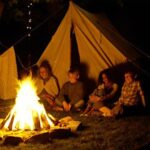by Liz Childers
“Last week we asked where you were planning on winter camping. We received a few scoffing answers, which I expected. To be honest, I’m not too keen on the idea. 65° is pretty chilly for me, so I’m not exactly craving an evening of sleeping in the snow.
Take out the cold factor, however, and there’s a lot of appeal. I really do love the woods in the winter. The bare tree branches framed against a grey sky and the strange silence that takes over are so enjoyable. With that in mind, I’ve done a bit of research. Obviously, there are many, many things to consider before heading into the woods in freezing temperatures (namely, clothing), but I wanted to share with you the basics that I’ve found on simply setting up camp in the winter so that you can stay warm(ish).
I know there are more experienced winter campers out there – what tips do you have to share?
Protect your tent from the wind
An icy wind will make it even harder to stay warm and comfortable at night. There are two main ways to protect yourself and your tent from these cold winds. First, find the place in your campsite that is best protected. This will probably be behind thick trees. Secondly, tie a tarp between two trees to create a windscreen that will help block the wind from reaching your tent.
Choose a snowy place for your tent
This sounds like a no-brainer now that I know it. However, if I had walked into a snowy campsite yesterday, I can guarantee I would have staked my tent in the least snowy place. Good Leave-No-Trace camping says to set up your tent on the snow; when the spring comes and the snow melts, there will be no evidence that you camped there. If you staked your tent on a grassy area that has remained relatively snow free due to protection, you will damage the plants. To make the snowy site more tent-friendly, pack the snow down so it’s firm. Loose snow will melt underneath your body; imagine trying to sleep in a mold conformed to your first sleeping position of the night – uncomfortable.
Bring a 4-season tent
If you’re worried about snow during your winter camping, then a 3-season tent should not be on your packing list. 3-season tents tend to be too ventilated to block icy winds and may not be sturdy enough to handle snow. 4-season tents are designed to shed snow, are durable enough to handle the wind and snow that could be forced their way, and have thicker walls that provide insulation to keep you warm.
Make Sure Your Tent Stakes Will Work
Standard tent stakes will not work well in the snow. Get snow stakes or snow anchors. Snow stakes have holes in the metal. When you put the stakes in the ground, the holes, which line the stake, fill with snow. This keeps the stake in the ground. Anchors, which are also good options, capture the snow in a “bag” which you can then bury slightly under more snow. Both of these items work well in sand, too, so you can do some beach camping once the snow melts.”



